Remote Sensing of Soil Organic Carbon at Regional Scale Based on Deep Learning: A Case Study of Agro-Pastoral Ecotone in Northern China
Abstract
:1. Introduction
2. Materials and Methods
2.1. Overview of Study Area
2.2. SOC Sampling and Laboratory Analysis
2.3. Remote Sensing Images and Preprocessing
2.4. Boruta Feature Selection Algorithm
2.5. Random Forest Regression
2.6. Fully Connected Deep Learning Network
2.7. Model Evaluation and Uncertainty Analysis
3. Results
3.1. Exploratory Data Analysis
3.2. The Feature Results Selected by the Boruta Algorithm
3.3. Random Forest Regression Model
3.4. Fully Connected Neural Network Model
3.5. Spatial Distribution of 0–30 cm SOCD in the Agro–Pastoral Ecotone in Northern China
4. Discussion
4.1. Factors Affecting the Accuracy of a SOC Inversion Model Established by Machine Learning
4.2. SOC in Different Land Use Types
4.3. Limitations of the Model and Future Developments
5. Conclusions
Author Contributions
Funding
Acknowledgments
Conflicts of Interest
References
- Post, W.M.; Peng, T.-H.; Emanuel, W.R.; King, A.W.; Dale, V.H.; DeAngelis, D.L. The global carbon cycle. Am. Sci. 1990, 78, 310–326. [Google Scholar]
- Jiao, S.; Li, J.; Li, Y.; Xu, Z.; Kong, B.; Li, Y.; Shen, Y. Variation of soil organic carbon and physical properties in relation to land uses in the Yellow River Delta, China. Sci. Rep. 2020, 10, 20317. [Google Scholar] [CrossRef] [PubMed]
- Lal, R. Restoring Soil Quality to Mitigate Soil Degradation. Sustainability 2015, 7, 5875–5895. [Google Scholar] [CrossRef] [Green Version]
- Hamzehpour, N.; Shafizadeh-Moghadam, H.; Valavi, R. Exploring the driving forces and digital mapping of soil organic carbon using remote sensing and soil texture. Catena 2019, 182, 104141. [Google Scholar] [CrossRef]
- Mallik, S.; Bhowmik, T.; Mishra, U.; Paul, N. Mapping and prediction of soil organic carbon by an advanced geostatistical technique using remote sensing and terrain data. Geocarto Int. 2022, 37, 2198–2214. [Google Scholar] [CrossRef]
- Mirzaee, S.; Ghorbani-Dashtaki, S.; Mohammadi, J.; Asadi, H.; Asadzadeh, F. Spatial variability of soil organic matter using remote sensing data. Catena 2016, 145, 118–127. [Google Scholar] [CrossRef]
- Falloon, P.; Smith, P. Simulating SOC changes in long-term experiments with RothC and CENTURY: Model evaluation for a regional scale application. Soil Use Manag. 2002, 18, 101–111. [Google Scholar] [CrossRef]
- Li, C.; Frolking, S.; Frolking, T.A. A model of nitrous oxide evolution from soil driven by rainfall events: 1. Model structure and sensitivity. J. Geophys. Res. Atmos. 1992, 97, 9759–9776. [Google Scholar] [CrossRef]
- Jastrow, J.D.; Amonette, J.E.; Bailey, V.L. Mechanisms controlling soil carbon turnover and their potential application for enhancing carbon sequestration. Clim. Change 2007, 80, 5–23. [Google Scholar] [CrossRef]
- Qin, C.Z.; Zhu, A.X.; Qiu, W.L.; Lu, Y.J.; Li, B.L.; Pei, T. Mapping soil organic matter in small low-relief catchments using fuzzy slope position information. Geoderma 2012, 171, 64–74. [Google Scholar] [CrossRef]
- Rossel, R.A.V.; Walvoort, D.J.J.; McBratney, A.B.; Janik, L.J.; Skjemstad, J.O. Visible, near infrared, mid infrared or combined diffuse reflectance spectroscopy for simultaneous assessment of various soil properties. Geoderma 2006, 131, 59–75. [Google Scholar] [CrossRef]
- Croft, H.; Kuhn, N.; Anderson, K. On the use of remote sensing techniques for monitoring spatio-temporal soil organic carbon dynamics in agricultural systems. Catena 2012, 94, 64–74. [Google Scholar] [CrossRef]
- Nocita, M.; Stevens, A.; Toth, G.; Panagos, P.; van Wesemael, B.; Montanarella, L. Prediction of soil organic carbon content by diffuse reflectance spectroscopy using a local partial least square regression approach. Soil Biol. Biochem. 2014, 68, 337–347. [Google Scholar] [CrossRef]
- Tatzber, M.; Mutsch, F.; Mentler, A.; Leitgeb, E.; Englisch, M.; Gerzabek, M.H. Determination of organic and inorganic carbon in forest soil samples by mid-infrared spectroscopy and partial least squares regression. Appl. Spectrosc. 2010, 64, 1167–1175. [Google Scholar] [CrossRef] [PubMed]
- Ben-Dor, E.; Inbar, Y.; Chen, Y. The reflectance spectra of organic matter in the visible near-infrared and short wave infrared region (400–2500 nm) during a controlled decomposition process. Remote Sens. Environ. 1997, 61, 1–15. [Google Scholar] [CrossRef]
- Zhang, L.P.; Zhang, L.F.; Du, B. Deep Learning for Remote Sensing Data A technical tutorial on the state of the art. Ieee Geosci. Remote Sens. Mag. 2016, 4, 22–40. [Google Scholar] [CrossRef]
- Guo, L.; Fu, P.; Shi, T.Z.; Chen, Y.Y.; Zhang, H.T.; Meng, R.; Wang, S.Q. Mapping field-scale soil organic carbon with unmanned aircraft system-acquired time series multispectral images. Soil Tillage Res. 2020, 196, 104477. [Google Scholar] [CrossRef]
- Wang, X.P.; Zhang, F.; Kung, H.T.; Johnson, V.C. New methods for improving the remote sensing estimation of soil organic matter content (SOMC) in the Ebinur Lake Wetland National Nature Reserve (ELWNNR) in northwest China. Remote Sens. Environ. 2018, 218, 104–118. [Google Scholar] [CrossRef]
- Emadi, M.; Taghizadeh-Mehrjardi, R.; Cherati, A.; Danesh, M.; Mosavi, A.; Scholten, T. Predicting and Mapping of Soil Organic Carbon Using Machine Learning Algorithms in Northern Iran. Remote Sens. 2020, 12, 2234. [Google Scholar] [CrossRef]
- Yang, L.; Cai, Y.Y.; Zhang, L.; Guo, M.; Li, A.Q.; Zhou, C.H. A deep learning method to predict soil organic carbon content at a regional scale using satellite-based phenology variables. Int. J. Appl. Earth Obs. Geoinf. 2021, 102, 102428. [Google Scholar] [CrossRef]
- Chengping, L.; Jiyu, X. Ecologically Vulnerable Characteristics of the farming-Pastoral Zigzag Zone In Northern China. J. Arid. Land Resour. Environ. 1995, 9, 1–7. [Google Scholar]
- Yu-Qiang, L.; Ha-Lin, Z.; Xiao-Yong, Y.; Xiao-An, Z.; Yin-ping, C. Dynamics of Carbon and Nitrogen Storages in Plant-Soil System During Desertification Process in Horqin Sandy Land. Environ. Sci. 2006, 4, 635–640. [Google Scholar] [CrossRef]
- Liu, Z.; Liu, Y.; Li, Y. Anthropogenic contributions dominate trends of vegetation cover change over the farming-pastoral ecotone of northern China. Ecol. Indic. 2018, 95, 370–378. [Google Scholar] [CrossRef]
- Liu, D.; Chen, J.; Ouyang, Z. Responses of landscape structure to the ecological restoration programs in the farming-pastoral ecotone of Northern China. Sci. Total Environ. 2020, 710, 136311. [Google Scholar] [CrossRef]
- Zhou, Z.; Sun, O.J.; Huang, J.; Li, L.; Liu, P.; Han, X. Soil carbon and nitrogen stores and storage potential as affected by land-use in an agro-pastoral ecotone of northern China. Biogeochemistry 2007, 82, 127–138. [Google Scholar] [CrossRef]
- Wang, X.Y.; Li, Y.G.; Gong, X.W.; Niu, Y.Y.; Chen, Y.P.; Shi, X.P.; Li, W. Storage, pattern and driving factors of soil organic carbon in an ecologically fragile zone of northern China. Geoderma 2019, 343, 155–165. [Google Scholar] [CrossRef]
- Wang, X.Y.; Li, Y.Q.; Chen, Y.P.; Lian, J.; Luo, Y.Q.; Niu, Y.Y.; Gong, X.W. Spatial pattern of soil organic carbon and total nitrogen, and analysis of related factors in an agro-pastoral zone in Northern China. PLoS ONE 2018, 13, e0197451. [Google Scholar] [CrossRef] [Green Version]
- Chen, Y.; Li, Y.Q.; Wang, X.Y.; Wan, J.L.; Gong, X.W.; Niu, Y.Y.; Liu, J. Estimating soil organic carbon density in Northern China’s agro-pastoral ecotone using vis-NIR spectroscopy. J. Soils Sediments 2020, 20, 3698–3711. [Google Scholar] [CrossRef]
- Wang, L.P.; Wang, X.; Wang, D.Y.; Qi, B.S.; Zheng, S.F.; Liu, H.J.; Luo, C.; Li, H.X.; Meng, L.H.; Meng, X.T.; et al. Spatiotemporal Changes and Driving Factors of Cultivated Soil Organic Carbon in Northern China’s Typical Agro-Pastoral Ecotone in the Last 30 Years. Remote Sens. 2021, 13, 3607. [Google Scholar] [CrossRef]
- Yuan, Q.Q.; Shen, H.F.; Li, T.W.; Li, Z.W.; Li, S.W.; Jiang, Y.; Xu, H.Z.; Tan, W.W.; Yang, Q.Q.; Wang, J.W.; et al. Deep learning in environmental remote sensing: Achievements and challenges. Remote Sens. Environ. 2020, 241, 111716. [Google Scholar] [CrossRef]
- Shidan, B. Soil Analysis in Agricultural Chemistry; China Agriculture Press: Beijing, China, 2000. [Google Scholar]
- Vermote, E.; Justice, C.; Claverie, M.; Franch, B. Preliminary analysis of the performance of the Landsat 8/OLI land surface reflectance product. Remote Sens. Environ. 2016, 185, 46–56. [Google Scholar] [CrossRef] [PubMed]
- Zhiyong, L. Spatial Patterns of Soil Carbon and Their Control in the Steppe of Northern Mongolian Plateau. Ph’D Thesis, Inner Mongolia University, Inner Mongolia, China, 2017. [Google Scholar]
- Rouse, J.W.; Haas, R.H.; Schell, J.A.; Deering, D.W. Monitoring vegetation systems in the Great Plains with ERTS. NASA Spec. Public 1974, 351, 309. [Google Scholar]
- Qi, J.; Chehbouni, A.; Huete, A.R.; Kerr, Y.H.; Sorooshian, S. A modified soil adjusted vegetation index. Remote Sens. Environ. 1994, 48, 119–126. [Google Scholar] [CrossRef]
- Huete, A.; Justice, C.; Van Leeuwen, W. MODIS vegetation index (MOD13). Algorithm Theor. Basis Doc. 1999, 3, 295–309. [Google Scholar]
- Jamalabad, M.S.; Abkar, A.A. Forest Canopy Density Monitoring, Using Satellite Images. Available online: https://www.researchgate.net/publication/263901692_FOREST_CANOPY_DENSITY_ESTIMATING_USING_SATELLITE_IMAGES (accessed on 22 March 2023).
- Huete, A.R. A soil-adjusted vegetation index (SAVI). Remote Sens. Environ. 1988, 25, 295–309. [Google Scholar] [CrossRef]
- Baret, F.; Guyot, G. Potentials and limits of vegetation indices for LAI and APAR assessment. Remote Sens. Environ. 1991, 35, 161–173. [Google Scholar] [CrossRef]
- Deering, D.W. Measuring Forage Production of Grazing Units from Landsat MSS Data. Available online: https://www.semanticscholar.org/paper/Measuring-forage-production-of-grazing-units-from-Deering/bbdad3db3dc2c59ccf145407390a0771011c44b9 (accessed on 22 March 2023).
- Richardson, A.J.; Wiegand, C. Distinguishing vegetation from soil background information. Photogramm. Eng. Remote Sens. 1977, 43, 1541–1552. [Google Scholar]
- Gitelson, A.A.; Merzlyak, M.N. Remote sensing of chlorophyll concentration in higher plant leaves. Adv. Space Res. 1998, 22, 689–692. [Google Scholar] [CrossRef]
- Scudiero, E.; Skaggs, T.H.; Corwin, D.L. Regional-scale soil salinity assessment using Landsat ETM+ canopy reflectance. Remote Sens. Environ. 2015, 169, 335–343. [Google Scholar] [CrossRef] [Green Version]
- Allbed, A.; Kumar, L.; Aldakheel, Y.Y. Assessing soil salinity using soil salinity and vegetation indices derived from IKONOS high-spatial resolution imageries: Applications in a date palm dominated region. Geoderma 2014, 230, 1–8. [Google Scholar] [CrossRef]
- Abbas, A.; Khan, S. Using remote sensing techniques for appraisal of irrigated soil salinity. In Proceedings of the International Congress on Modelling and Simulation (MODSIM), Christenchurch, New Zealand, 10–13 December 2007; pp. 2632–2638. [Google Scholar]
- Delavar, M.A.; Naderi, A.; Ghorbani, Y.; Mehrpouyan, A.; Bakhshi, A. Soil salinity mapping by remote sensing south of Urmia Lake, Iran. Geoderma Reg. 2020, 22, e00317. [Google Scholar] [CrossRef]
- Rikimaru, A.; Roy, P.; Miyatake, S. Tropical forest cover density mapping. Trop. Ecol. 2002, 43, 39–47. [Google Scholar]
- Developers, G. USGS Landsat 8 Level 2, Collection 2, Tier 2. 2013. Available online: https://developers.google.com/earth-engine/datasets/catalog/LANDSAT_LC08_C02_T2_L2 (accessed on 22 March 2023).
- Todd, S.W.; Hoffer, R.M. Responses of spectral indices to variations in vegetation cover and soil background. Photogramm. Eng. Remote Sens. 1998, 64, 915–922. [Google Scholar]
- Kursa, M.B.; Rudnicki, W.R. Feature selection with the Boruta package. J. Stat. Softw. 2010, 36, 1–13. [Google Scholar] [CrossRef] [Green Version]
- Chawla, N.V.; Bowyer, K.W.; Hall, L.O.; Kegelmeyer, W.P. SMOTE: Synthetic minority over-sampling technique. J. Artif. Intell. Res. 2002, 16, 321–357. [Google Scholar] [CrossRef]
- Pan, S.J.; Yang, Q. A survey on transfer learning. IEEE Trans. Knowl. Data Eng. 2009, 22, 1345–1359. [Google Scholar] [CrossRef]
- Minasny, B.; Setiawan, B.I.; Arif, C.; Saptomo, S.K.; Chadirin, Y. Digital mapping for cost-effective and accurate prediction of the depth and carbon stocks in Indonesian peatlands. Geoderma 2016, 272, 20–31. [Google Scholar]
- Odebiri, O.; Mutanga, O.; Odindi, J. Deep learning-based national scale soil organic carbon mapping with Sentinel-3 data. Geoderma 2022, 411, 115695. [Google Scholar] [CrossRef]
- Bhattacharya, S.; Rajan, V.; Shrivastava, H. ICU mortality prediction: A classification algorithm for imbalanced datasets. In Proceedings of the AAAI Conference on Artificial Intelligence, San Francisco, CA, USA, 4–9 February 2017; Volume 31. [Google Scholar]
- Ma, L.; Zhao, L.; Cao, L.; Li, D.; Chen, G.; Han, Y. Inversion of Soil Organic Matter Content Based on Improved Convolutional Neural Network. Sensors 2022, 22, 7777. [Google Scholar] [CrossRef]
- Lin, L.; Wang, Y.; Teng, J.; Wang, X. Hyperspectral analysis of soil organic matter in coal mining regions using wavelets, correlations, and partial least squares regression. Environ. Monit. Assess. 2016, 188, 97. [Google Scholar] [CrossRef]
- Shi, Z.; Ji, W.; Viscarra Rossel, R.; Chen, S.; Zhou, Y. Prediction of soil organic matter using a spatially constrained local partial least squares regression and the C hinese vis–NIR spectral library. Eur. J. Soil Sci. 2015, 66, 679–687. [Google Scholar] [CrossRef]
- Silvero, N.E.Q.; Di Raimo, L.A.D.L.; Pereira, G.S.; De Magalhães, L.P.; da Silva Terra, F.; Dassan, M.A.A.; Salazar, D.F.U.; Demattê, J.A. Effects of water, organic matter, and iron forms in mid-IR spectra of soils: Assessments from laboratory to satellite-simulated data. Geoderma 2020, 375, 114480. [Google Scholar] [CrossRef]
- Kätterer, T.; Reichstein, M.; Andrén, O.; Lomander, A. Temperature dependence of organic matter decomposition: A critical review using literature data analyzed with different models. Biol. Fertil. Soils 1998, 27, 258–262. [Google Scholar] [CrossRef]
- Conant, R.T.; Ryan, M.G.; Ågren, G.I.; Birge, H.E.; Davidson, E.A.; Eliasson, P.E.; Evans, S.E.; Frey, S.D.; Giardina, C.P.; Hopkins, F.M. Temperature and soil organic matter decomposition rates–synthesis of current knowledge and a way forward. Glob. Change Biol. 2011, 17, 3392–3404. [Google Scholar] [CrossRef]
- Luo, Y.; Hui, D.; Zhang, D. Elevated CO2 stimulates net accumulations of carbon and nitrogen in land ecosystems: A meta-analysis. Ecology 2006, 87, 53–63. [Google Scholar] [CrossRef] [Green Version]
- Zhao, Y.; Ding, Y.; Hou, X.; Li, F.Y.; Han, W.; Yun, X. Effects of temperature and grazing on soil organic carbon storage in grasslands along the Eurasian steppe eastern transect. PLoS ONE 2017, 12, e0186980. [Google Scholar] [CrossRef] [Green Version]
- Evans, S.E.; Burke, I.C.; Lauenroth, W.K. Controls on soil organic carbon and nitrogen in Inner Mongolia, China: A cross-continental comparison of temperate grasslands. Glob. Biogeochem. Cycles 2011, 25. [Google Scholar] [CrossRef] [Green Version]
- Wang, L.; Gan, Y.; Wiesmeier, M.; Zhao, G.; Zhang, R.; Han, G.; Siddique, K.H.; Hou, F. Grazing exclusion—An effective approach for naturally restoring degraded grasslands in Northern China. Land Degrad. Dev. 2018, 29, 4439–4456. [Google Scholar] [CrossRef]
- Liu, Z.; Zhou, Q.; Ma, Q.; Kuang, W.; Daryanto, S.; Wang, L.; Wu, J.; Liu, B.; Zhu, J.; Cao, C. Scale effect of climate factors on soil organic carbon stock in natural grasslands of northern China. Ecol. Indic. 2023, 146, 109757. [Google Scholar] [CrossRef]
- Zhao, X.-X. The Spatio-Temporal Dynamics and Driving Factors of Grassland Net Primary Productivity in the Farming-Pastoral Ecotone of Inner Mongolia. Master’s Thesis, Inner Mongolia University, Inner Mongolia, China, 2023. [Google Scholar]
- Yao, Y.F.; Ge, N.N.; Yu, S.; Wei, X.R.; Wang, X.; Jin, J.W.; Liu, X.T.; Shao, M.G.; Wei, Y.C.; Kang, L. Response of aggregate associated organic carbon, nitrogen and phosphorous to re-vegetation in agro-pastoral ecotone of northern China. Geoderma 2019, 341, 172–180. [Google Scholar] [CrossRef]
- Yuan, J.; Ouyang, Z.; Zheng, H.; Su, Y. Ecosystem carbon storage following different approaches to grassland restoration in south-eastern Horqin Sandy Land, northern China. Glob. Ecol. Conserv. 2021, 26, e01438. [Google Scholar] [CrossRef]
- Meng, Y.; Xuyang, W.; Liye, Z.; Yuqiang, L. Characteristics and influencing factors of soil organic carbon in the process of desertification in Horqin Sandy Land. J. Desert Res. 2022, 42, 221–231. [Google Scholar]
- Jun, L. Estimation of Soil Nutrients Loss by Wind Erosion in the Agro-Pastoral Ecotone of Northern China. Master’s Thesis, Hebei Normal University, Shijiazhuang, China, 2021. [Google Scholar]
- Wiesmeier, M.; Munro, S.; Barthold, F.; Steffens, M.; Schad, P.; Kögel-Knabner, I. Carbon storage capacity of semi-arid grassland soils and sequestration potentials in northern China. Glob. Change Biol. 2015, 21, 3836–3845. [Google Scholar] [CrossRef] [PubMed]
- Tarvainen, A.; Valpola, H. Mean teachers are better role models: Weight-averaged consistency targets improve semi-supervised deep learning results. Adv. Neural Inf. Process. Syst. 2017, 30. [Google Scholar] [CrossRef]
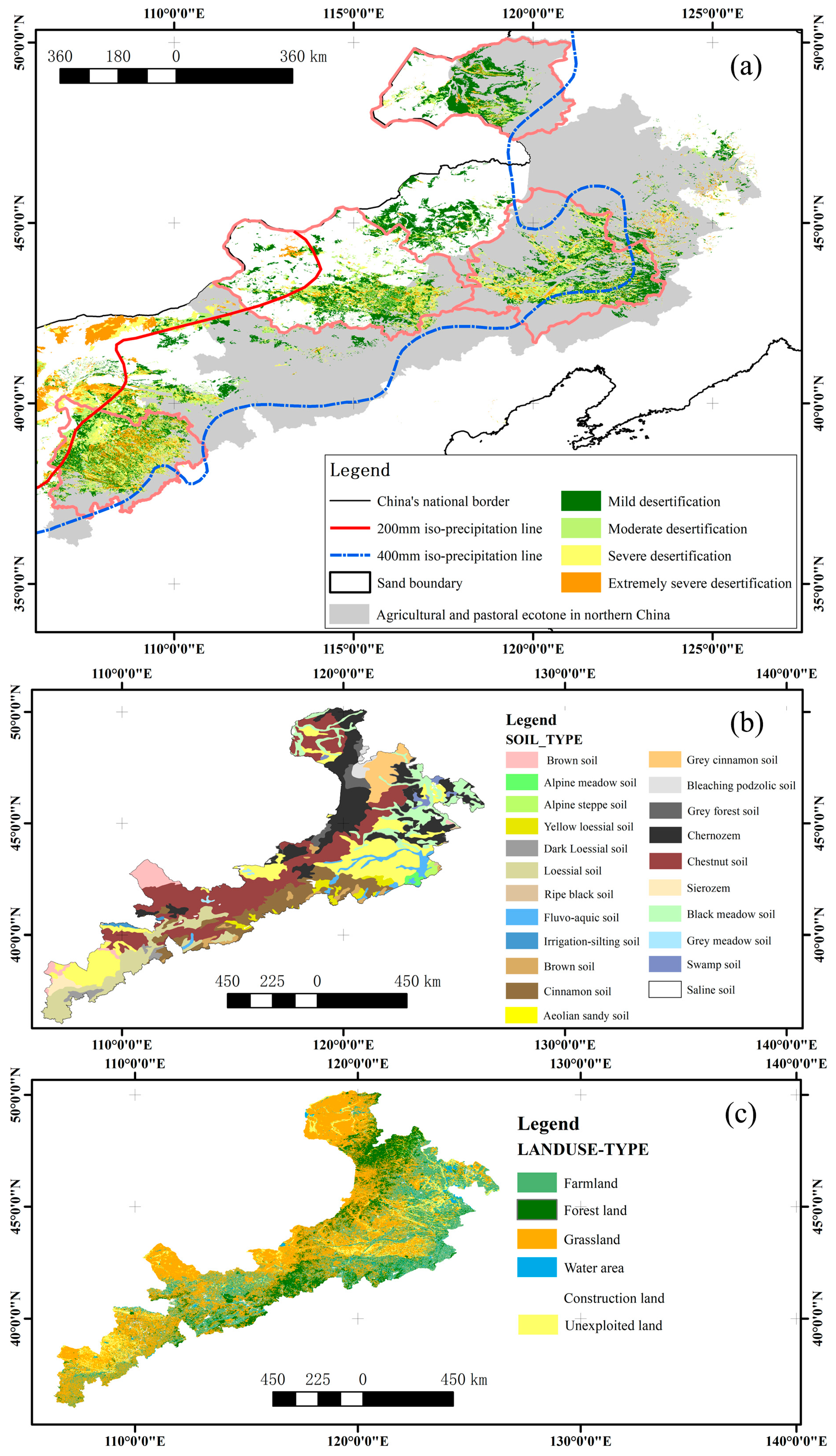
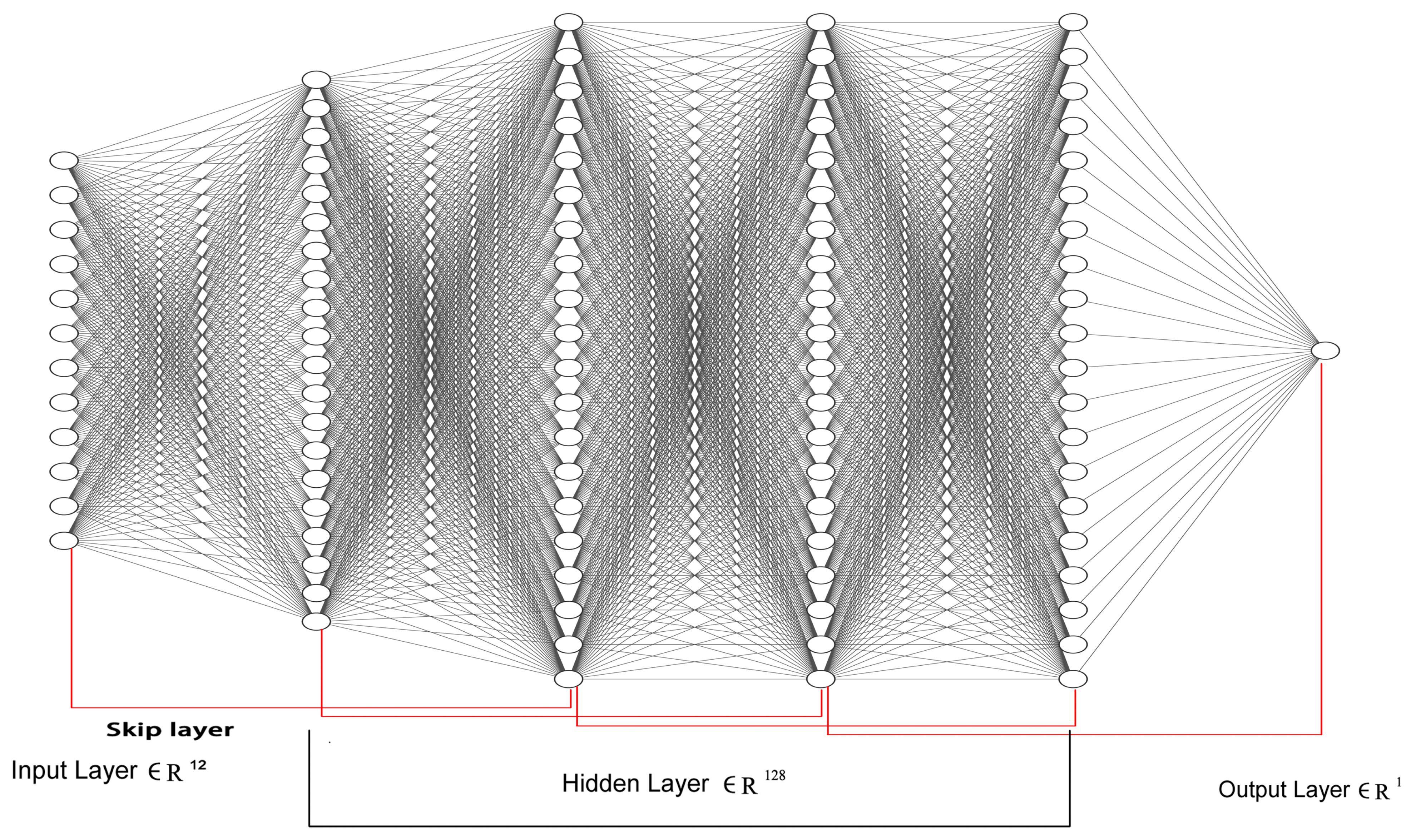


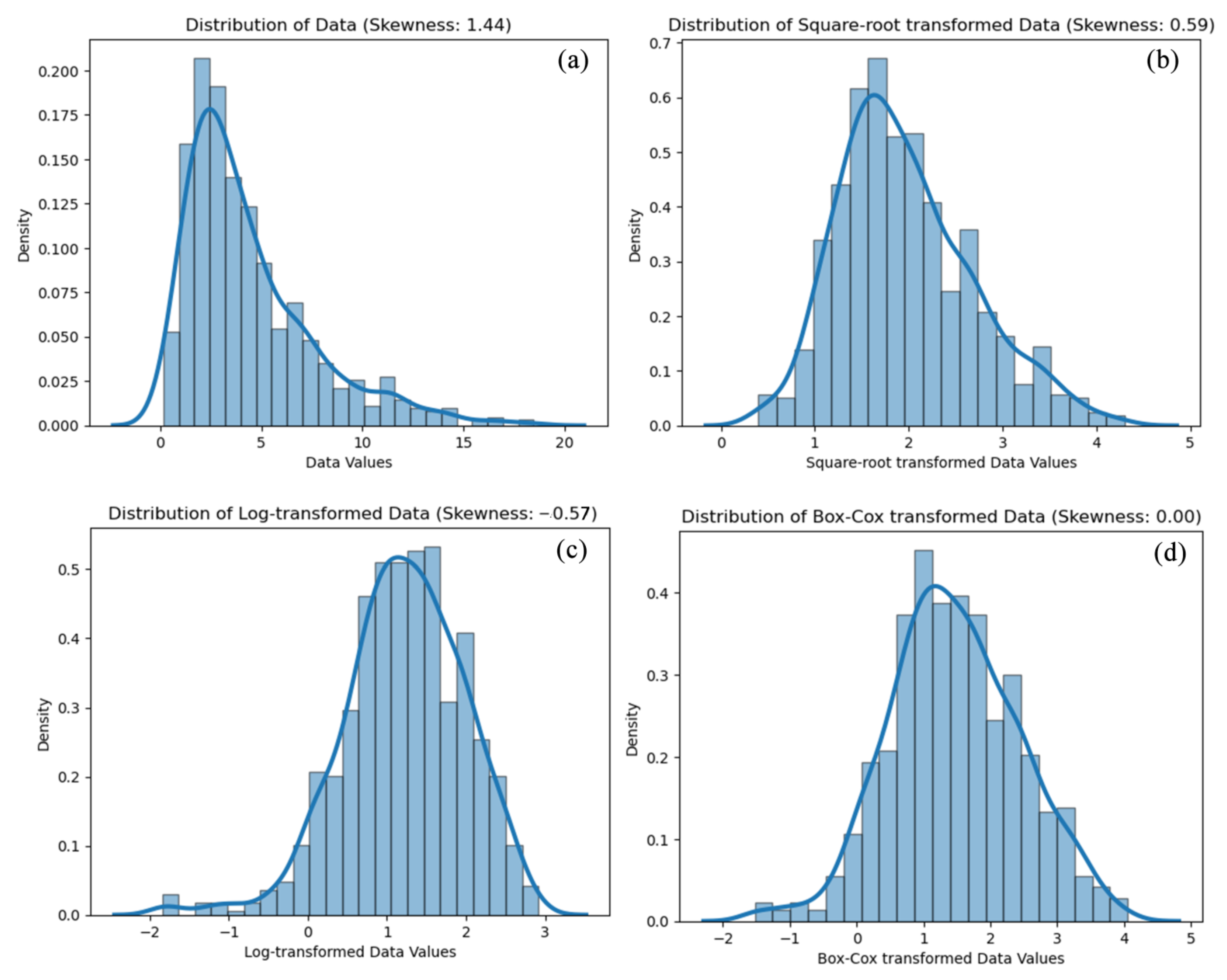
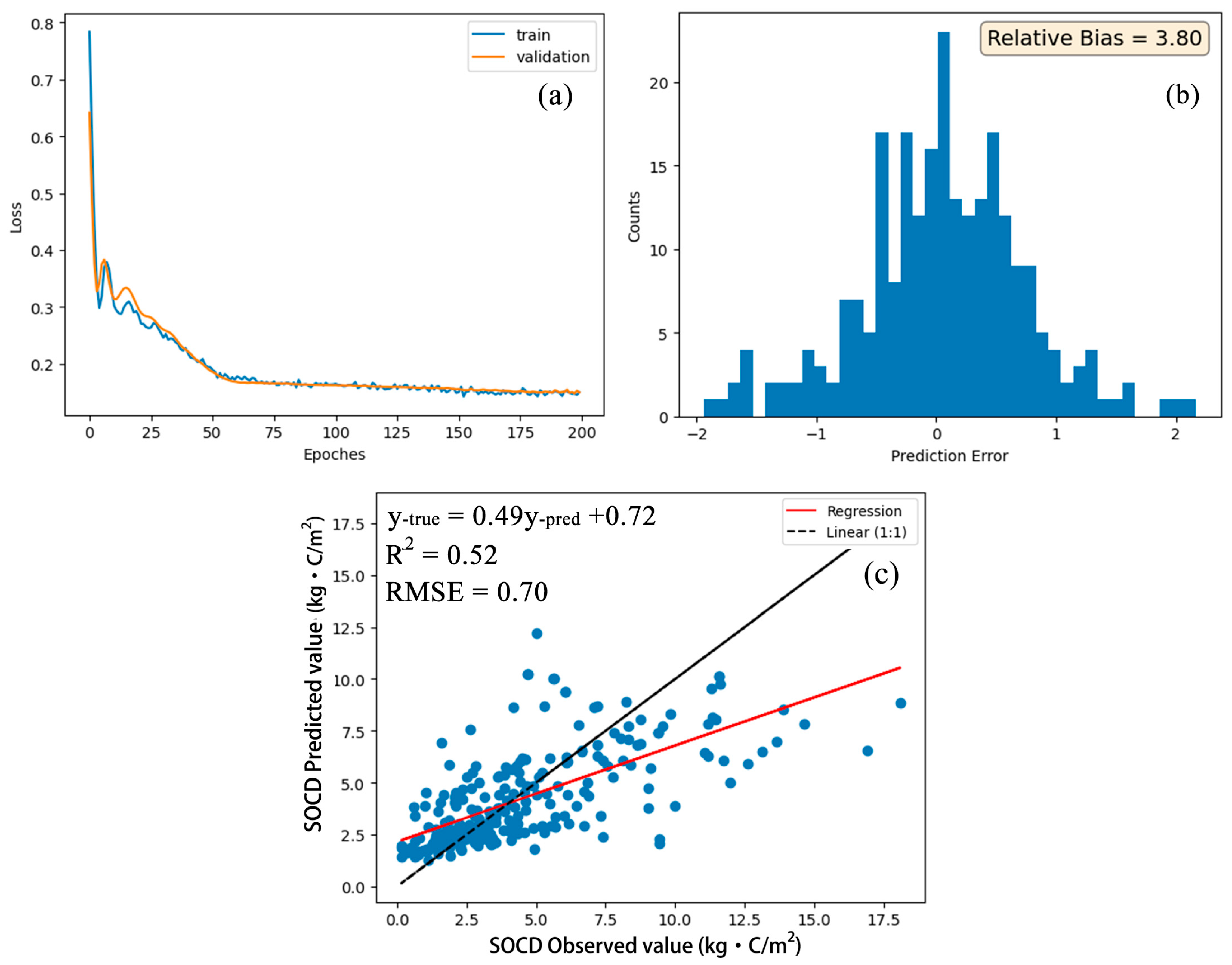
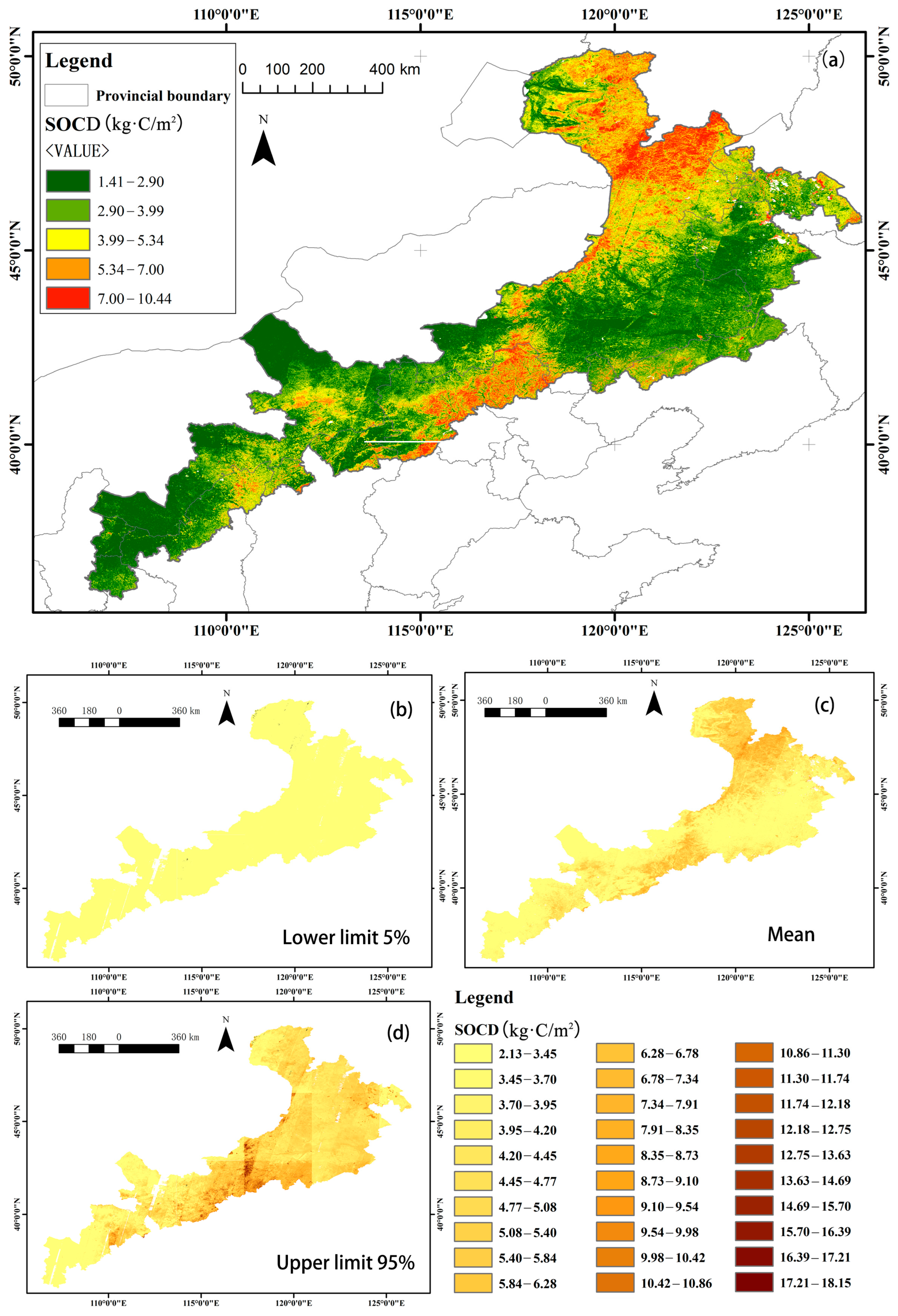

| Type | Name of Index | Formula | Reference | Name of Index | Formula | Reference |
|---|---|---|---|---|---|---|
| Vegetation index | Normalized Difference Vegetation Index (NDVI) | [34] | Modified Soil Adjusted Vegetation Index (MSAVI) | [35] | ||
| Enhanced Vegetation Index (EVI) | [36] | Optimized Soil Adjusted Vegetation Index (OSAVI) | 1.16 | [37] | ||
| Soil Adjusted Vegetation Index (SAVI) | [38] | Ratio Vegetation Index (RVI) | [39] | |||
| Renormalized Difference Vegetation Index (RDVI) | [39] | Transformed Vegetation Index (TVI) | [40] | |||
| Difference Vegetation Index (DVI) | [41] | Green Normalized Difference Vegetation Index (GDVI) | [42] | |||
| Soil index | Canopy Response Salinity Index (CRSI) | [43] | Salinity Index (SI-T) | [44] | ||
| Salinity Index (SI) | [45] | Salinity Index-1 (SI-1) | [45] | |||
| Salinity Index-2(SI-2) | [45] | Salinity Index-3 (SI-3) | [45] | |||
| Salinity Index-4(SI-4) | [45] | Salinity Index-5 (SI-5) | [45] | |||
| Salinity Ratio (SAIO) | [46] | S1 (Soil Index 1) | [44] | |||
| S2 (Soil Index 2) | [44] | S3 (Soil Index 3) | [44] | |||
| Bare Soil Index (IBI_temp) | [47] | Salinity Index-temp (SI-temp) | ||||
| Meteorological index | Land Surface Temperature (LST) | [48] | Surface Moisture (WETtemp) | [49] | ||
| Topographic factor | Elevation | ASTER GDEM v2 | [48] | Slope | [48] | |
| Aspect | [48] | |||||
| Band combination index | Ratio Index (RIBiBj) | Difference index (DIBiBj) | ||||
| Normalized index (NDIBiBj) |
| Land Use Type | Kriging Interpolation Result (Tg) | DNN Result (Tg) |
|---|---|---|
| Farmland | 639.02 | 639.57 |
| Forest land | 405.17 | 328.32 |
| Shrubland | 101.20 | 130.01 |
| Sparse woodland | 39.83 | 49.52 |
| High coverage grassland | 493.93 | 469.31 |
| Medium coverage grassland | 287.81 | 391.75 |
| Low coverage grassland | 104.11 | 136.35 |
| Sandy land | 59.06 | 70.98 |
Disclaimer/Publisher’s Note: The statements, opinions and data contained in all publications are solely those of the individual author(s) and contributor(s) and not of MDPI and/or the editor(s). MDPI and/or the editor(s) disclaim responsibility for any injury to people or property resulting from any ideas, methods, instructions or products referred to in the content. |
© 2023 by the authors. Licensee MDPI, Basel, Switzerland. This article is an open access article distributed under the terms and conditions of the Creative Commons Attribution (CC BY) license (https://creativecommons.org/licenses/by/4.0/).
Share and Cite
Guo, Z.; Li, Y.; Wang, X.; Gong, X.; Chen, Y.; Cao, W. Remote Sensing of Soil Organic Carbon at Regional Scale Based on Deep Learning: A Case Study of Agro-Pastoral Ecotone in Northern China. Remote Sens. 2023, 15, 3846. https://doi.org/10.3390/rs15153846
Guo Z, Li Y, Wang X, Gong X, Chen Y, Cao W. Remote Sensing of Soil Organic Carbon at Regional Scale Based on Deep Learning: A Case Study of Agro-Pastoral Ecotone in Northern China. Remote Sensing. 2023; 15(15):3846. https://doi.org/10.3390/rs15153846
Chicago/Turabian StyleGuo, Zichen, Yuqiang Li, Xuyang Wang, Xiangwen Gong, Yun Chen, and Wenjie Cao. 2023. "Remote Sensing of Soil Organic Carbon at Regional Scale Based on Deep Learning: A Case Study of Agro-Pastoral Ecotone in Northern China" Remote Sensing 15, no. 15: 3846. https://doi.org/10.3390/rs15153846
APA StyleGuo, Z., Li, Y., Wang, X., Gong, X., Chen, Y., & Cao, W. (2023). Remote Sensing of Soil Organic Carbon at Regional Scale Based on Deep Learning: A Case Study of Agro-Pastoral Ecotone in Northern China. Remote Sensing, 15(15), 3846. https://doi.org/10.3390/rs15153846






